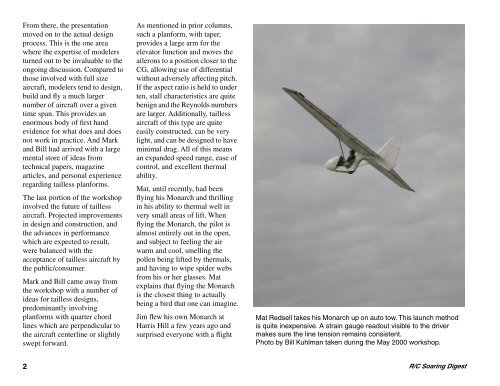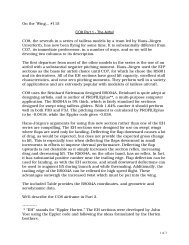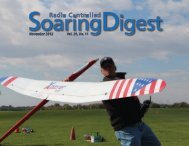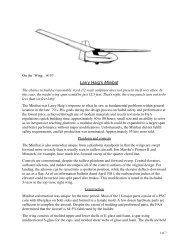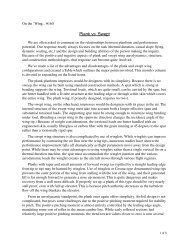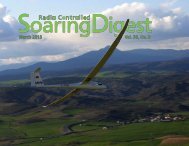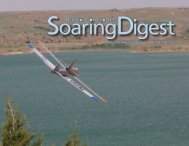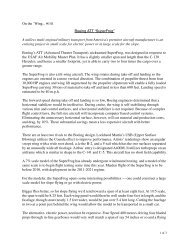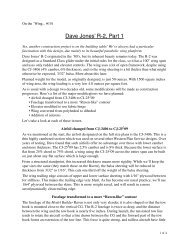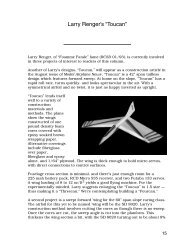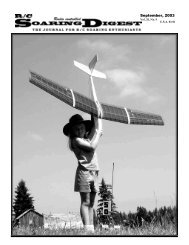Review of the July 2004 Flying Wing workshop - Mat's
Review of the July 2004 Flying Wing workshop - Mat's
Review of the July 2004 Flying Wing workshop - Mat's
- No tags were found...
You also want an ePaper? Increase the reach of your titles
YUMPU automatically turns print PDFs into web optimized ePapers that Google loves.
From <strong>the</strong>re, <strong>the</strong> presentationmoved on to <strong>the</strong> actual designprocess. This is <strong>the</strong> one areawhere <strong>the</strong> expertise <strong>of</strong> modelersturned out to be invaluable to <strong>the</strong>ongoing discussion. Compared tothose involved with full sizeaircraft, modelers tend to design,build and fly a much largernumber <strong>of</strong> aircraft over a giventime span. This provides anenormous body <strong>of</strong> first handevidence for what does and doesnot work in practice. And Markand Bill had arrived with a largemental store <strong>of</strong> ideas fromtechnical papers, magazinearticles, and personal experienceregarding tailless planforms.The last portion <strong>of</strong> <strong>the</strong> <strong>workshop</strong>involved <strong>the</strong> future <strong>of</strong> taillessaircraft. Projected improvementsin design and construction, and<strong>the</strong> advances in performancewhich are expected to result,were balanced with <strong>the</strong>acceptance <strong>of</strong> tailless aircraft by<strong>the</strong> public/consumer.Mark and Bill came away from<strong>the</strong> <strong>workshop</strong> with a number <strong>of</strong>ideas for tailless designs,predominantly involvingplanforms with quarter chordlines which are perpendicular to<strong>the</strong> aircraft centerline or slightlyswept forward.As mentioned in prior columns,such a planform, with taper,provides a large arm for <strong>the</strong>elevator function and moves <strong>the</strong>ailerons to a position closer to <strong>the</strong>CG, allowing use <strong>of</strong> differentialwithout adversely affecting pitch.If <strong>the</strong> aspect ratio is held to underten, stall characteristics are quitebenign and <strong>the</strong> Reynolds numbersare larger. Additionally, taillessaircraft <strong>of</strong> this type are quiteeasily constructed, can be verylight, and can be designed to haveminimal drag. All <strong>of</strong> this meansan expanded speed range, ease <strong>of</strong>control, and excellent <strong>the</strong>rmalability.Mat, until recently, had beenflying his Monarch and thrillingin his ability to <strong>the</strong>rmal well invery small areas <strong>of</strong> lift. Whenflying <strong>the</strong> Monarch, <strong>the</strong> pilot isalmost entirely out in <strong>the</strong> open,and subject to feeling <strong>the</strong> airwarm and cool, smelling <strong>the</strong>pollen being lifted by <strong>the</strong>rmals,and having to wipe spider websfrom his or her glasses. Matexplains that flying <strong>the</strong> Monarchis <strong>the</strong> closest thing to actuallybeing a bird that one can imagine.Jim flew his own Monarch atHarris Hill a few years ago andsurprised everyone with a flightMat Redsell takes his Monarch up on auto tow. This launch methodis quite inexpensive. A strain gauge readout visible to <strong>the</strong> drivermakes sure <strong>the</strong> line tension remains consistent.Photo by Bill Kuhlman taken during <strong>the</strong> May 2000 <strong>workshop</strong>.2 R/C Soaring Digest


